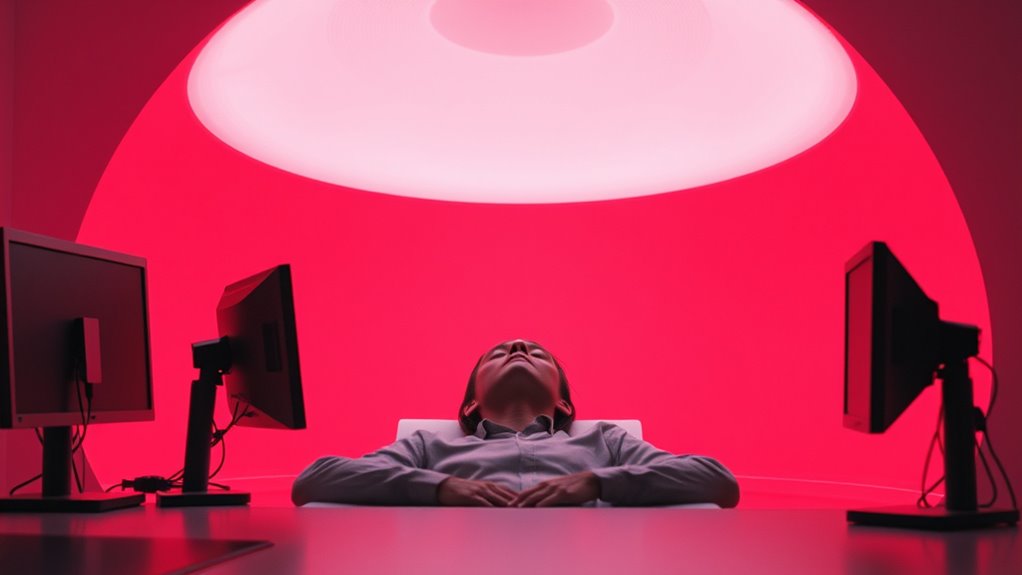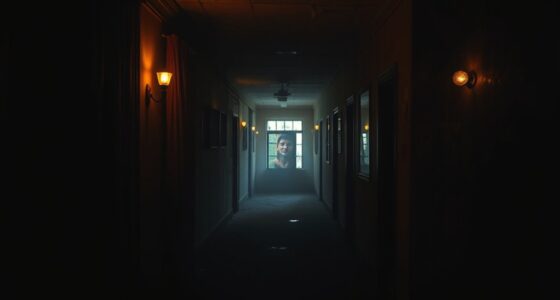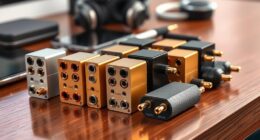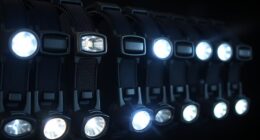Inside the Ganzfeld experiment, you’re placed in a sensory-deprived setting, with your eyes covered and gentle auditory stimuli to eliminate distractions. The goal is to enhance your perceptual sensitivity to subtle psychic cues or messages, which could indicate extrasensory perception. Researchers compare your impressions with target images or thoughts to find statistical significance. If you want to understand how these experiments are designed to detect ESP, keep exploring how they control sensory input and analyze results.
Key Takeaways
- The Ganzfeld experiment creates sensory deprivation to enhance the detection of potential ESP signals.
- Participants are covered with halved ping-pong balls and receive uniform auditory stimuli.
- The setup aims to minimize external cues, focusing on subconscious perception of telepathic messages.
- Data analysis compares participant impressions with target images to assess statistical significance.
- Rigorous controls and advanced statistical methods are used to validate whether ESP is demonstrated.
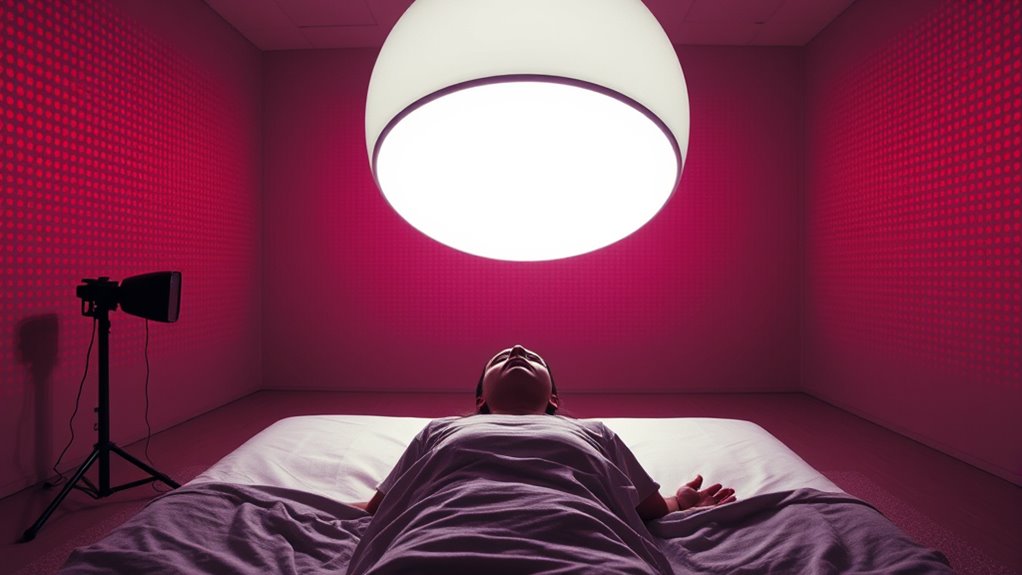
Testing ESP, or extrasensory perception, involves evaluating whether individuals can perceive information beyond the five senses. One of the most well-known methods used in this pursuit is the Ganzfeld experiment. Designed to investigate psychic phenomena, it aims to determine if people can receive telepathic messages or other extrasensory cues without relying on traditional sensory channels. When you participate in a Ganzfeld test, you’re subjected to a controlled environment that reduces sensory input, making your mind more receptive to subtle signals that might carry telepathic information.
The core idea behind the Ganzfeld experiment is to create a state of mild sensory deprivation, often by covering your eyes with halved ping-pong balls and playing uniform, diffuse auditory stimuli. This setup minimizes external distractions and helps focus your consciousness inward. Under these conditions, if psychic phenomena like mental telepathy are real, you might pick up on impressions or thoughts sent by a sender located elsewhere. The experiment then compares your impressions with the target information to see if there’s a statistically significant connection. Proper experimental design is essential to ensure that results are valid and not influenced by external factors or biases. Additionally, standardized procedures help maintain consistency across trials and reduce variability in outcomes. Conducting multiple trials with proper controls can also increase the reliability of the results.
While some skeptics argue that the results are inconclusive or that they can be explained through chance or sensory leakage, proponents believe the Ganzfeld experiment offers promising evidence of extrasensory perception. They suggest that if you’re able to accurately identify images or thoughts transmitted telepathically, it supports the existence of mental telepathy and other psychic phenomena. The experiment’s design aims to strip away normal sensory cues, making it easier to detect subtle extrasensory signals, if they exist.
When you’re involved in testing ESP through this method, you’re fundamentally exploring whether your mind can access information outside the normal channels of sight, sound, touch, taste, or smell. The process relies heavily on the idea that, under the right conditions, your subconscious might pick up on cues or thoughts that are not available to your conscious awareness. This makes the Ganzfeld experiment a fascinating tool for those interested in understanding the potential reach of human consciousness and the existence of psychic phenomena. Proper data analysis and interpretation are crucial to distinguish genuine effects from statistical anomalies.
Ultimately, the success of such tests hinges on rigorous controls and statistical analysis. Whether you’re a researcher or a participant, the goal remains to determine if the mind can truly transcend sensory limitations. The concept of mental telepathy, once considered purely science fiction, continues to be investigated through experiments like the Ganzfeld, pushing the boundaries of what we comprehend about perception and consciousness. Additionally, understanding the importance of thorough due diligence and proper experimental design is crucial in evaluating the validity of such studies. Recognizing potential sources of error and ensuring consistent procedures are fundamental to obtaining reliable results. Employing advanced statistical methods can further help interpret data accurately and reduce biases.
Frequently Asked Questions
What Are the Historical Origins of the Ganzfeld Experiment?
You’re curious about the ganzfeld experiment’s origins in parapsychology history. It started in the 1970s, inspired by earlier studies on sensory deprivation and telepathy. Researchers wanted to explore if sensory overload or deprivation could enhance extrasensory perception (ESP). The experiment’s design involves relaxing participants in a sensory-restricted environment. This approach aimed to uncover if mental telepathy or other psychic phenomena could be scientifically tested, marking a significant step in parapsychology research.
How Do Researchers Ensure Unbiased Results in Testing ESP?
Think of your experiment as a tightrope walk—balance is key. You guarantee unbiased results by implementing double blind procedures, so neither you nor participants influence outcomes. Additionally, statistical controls act as safety nets, helping you account for chance or bias. These methods keep your testing fair, reliable, and clear, allowing you to trust that any ESP effects observed are genuine rather than due to subconscious cues or experimental bias.
Are There Alternative Methods to the Ganzfeld Approach?
You can explore alternative methods to the Ganzfeld approach, such as sensory deprivation tanks or mental visualization exercises. These techniques aim to reduce external stimuli, focusing your mind inward and enhancing intuitive abilities. Unlike the Ganzfeld, which uses uniform sensory input, these methods rely on creating a calm, distraction-free environment that helps you concentrate and potentially access extrasensory perceptions more effectively.
What Are Common Criticisms of the Ganzfeld Experiment?
Like a fragile glass, the Ganzfeld experiment faces criticism for its methodological flaws and replication issues. You might notice that inconsistent results raise doubts about its reliability. Critics argue that subtle sensory cues or expectation biases could influence outcomes, undermining validity. These concerns highlight the need for stricter controls and standardized procedures, ensuring that findings are truly due to ESP rather than experimental artifacts or procedural shortcomings.
Has the Ganzfeld Experiment Led to Conclusive Evidence of ESP?
You might wonder if the Ganzfeld experiment provides conclusive evidence of ESP. While it aims at telepathy verification through sensory deprivation, results remain controversial. Critics argue that inconsistent findings and methodological flaws prevent it from definitively proving ESP exists. So, although it offers intriguing data, the Ganzfeld experiment hasn’t yet delivered solid, conclusive proof of telepathy or other ESP phenomena, leaving the question open for further investigation.
Conclusion
So, there you have it. The Ganzfeld experiment offers a glimpse into the mysterious world of ESP, making you wonder if the mind truly holds untapped powers. Just like trying to crack the Enigma code during WWII, testing extrasensory perception can feel like a leap into the unknown. While science hasn’t fully proven it yet, maybe someday you’ll be part of a groundbreaking discovery—who knows, perhaps even before the age of smartphones!
